#Encoder Research Report
Explore tagged Tumblr posts
Text

Horses are among the world’s most elite athletes: When galloping, they can consume twice as much oxygen per kilogram as the fittest humans. All that oxygen supercharges horses’ cells’ energy-producing compartments as they crank out ATP, the chemical needed to power their impressive muscles. But making so much cellular fuel so quickly comes with a catch: the manufacture of pernicious byproduct molecules called reactive oxygen species (ROS), which can wreak havoc in cells.
How horses dealt with this biological trade-off and evolved into premier endurance athletes has long intrigued biologists. Researchers report today in Science that they have uncovered a big part of it, identifying a key mutation that lets horses safely produce so much ATP. The trait helped pave the way for horses to go from dog-size critters millions of years ago to the high-endurance athletes we know today.
The study’s detailed molecular work makes it “exceptional,” says José Calbet, an expert on the cellular responses to exercise at the University of Las Palmas de Gran Canaria who wasn’t involved with the study.
The mutation in question occurs in the gene that encodes a protein called KEAP1, which acts as a biochemical bouncer, binding to a different protein called NRF2 to prevent it from entering the cell’s nucleus, where it would otherwise activate stress-response genes that help blunt cell damage.
But ROS can help NRF2 sneak in by causing KEAP1 to release its bind on the protein, allowing it to enter the nucleus and trigger the cell’s stress-response genes.
Johns Hopkins University ophthalmologist and clinician scientist Elia Duh, a senior author of the new study, didn’t set out to study horses. Initially, Duh was interested in the KEAP1-NRF2 system because its role in activating stress-response genes makes it a tempting target for treating inflammation—and aging-related conditions, such as blinding retinal diseases, irritable bowel syndrome, and neurodegeneration.
Duh wondered whether any insights could be gleaned from studying the evolution of these proteins in different animals. So, he teamed up with Gianni Castiglione, an evolutionary biologist and biochemist at Vanderbilt University. Together, they scanned hundreds of vertebrate genomes looking for notable mutations to the gene for KEAP1.
The team’s genomic work revealed birds had almost completely lost the gene, presumably an adaptation to the extreme demands of flight. When they looked in horses, researchers noticed what initially appeared to be a DNA sequence that encoded an unusually short—and therefore presumably nonfunctional—version of the KEAP1 protein. But when Duh’s and Castiglione’s team grew horse cells in culture, it discovered the protein was very much there and working. “Naturally, I was worried I was doing something wrong,” Castiglione says. “Then one day, a light bulb went off.”
As it turns out, the computer algorithm scientists had used to scan the horse genome had made a mistake. The algorithm had spotted a specific kind of mutation in the part of the KEAP1 gene that changed the messenger RNA from CGA—which codes for the amino acid arginine—to UGA, which is what’s known as a “stop codon.”
Normally, the cellular machinery interprets UGA as a sign to stop translating the RNA into a protein. But instead, the horses’ genetic machinery recodes the stop codon into a different amino acid, cysteine, causing it to ignore that order. This phenomenon, known as a stop codon read-through, is common among viruses but rare in multicellular organisms.
“The identification of this evolutionarily significant UGA recoding event represents a potentially seminal finding, offering a model for uncovering other yet-unidentified cases of stop codon read-through,” says Hozumi Motohashi, a biologist at Tohoku University who has studied KEAP1 and NRF2.
That the replacement is a cysteine is particularly notable, Castiglione says. KEAP1 senses cellular stress through its cysteines, which contain sulfur atoms whose reactions with ROS, induce the chemical changes that cause KEAP1 to let go of NRF2. The mutation the researchers had identified adds another place on KEAP1 for ROS to interact, which makes the protein more sensitive to stress—and lets horse cells respond much faster to the cellular stress of intense exercise. “It does make complete sense [that] by introducing another cysteine, another sulfur, you would have heightened sensitivity,” Castiglione says.
What’s more, this tweaking of KEAP1 is a “[key] genetic component to the puzzle of the evolution of horses,” Duh says. “Once they figured out how to run, they could occupy all kinds of ecological niches,” Castiglione adds.
The finding could also point the way toward new kinds of drugs to treat diseases by targeting the specific parts of the KEAP1 protein that help horses hoof it. “By looking at what evolution has figured out, we know this is a viable strategy,” Castiglione says.
Source
834 notes
·
View notes
Text
So … I rarely talk about politics on here. I prefer to take action in real-life, and put my time and money where my mouth is.
But, as a medical student and a United States citizen, there are some things I need you to know.
- Unfortunately, many states have laws requiring healthcare providers ask patients about their immigration status. You do not have to answer this. Despite what is encoded into law, you will not be turned away nor reported, especially if you are seeking emergency services. Do not let fear stop you from getting the care you need, that’s what the government wants.
- An executive order has withdrawn the United States from the World Health Organization. While the WHO is not perfect, they are responsible for some of the most comprehensive research networks, vaccine initiatives, healthcare surveillance systems, and pandemic response protocols around the globe. Every healthcare provider and medical student I know is worried about what this means for our future and the standard of care we are able to provide nationally.
- Dismantling DEI programs only serves to hurt already marginalized communities. Contrary to what the White House claims, DEI initiatives do not allow “less qualified” applicants to enter the workforce. Instead, they provide individuals who have systematically been given less opportunities a more equitable playing field. For example, only about 6.9% of physicians identify as Hispanic and about 5.7% of physicians identify as Black or African American in the United States. This is extremely disproportionate when looking at ethnicity statistics of the country as a whole. And it largely comes down to the same root cause — lack of resources. No medical school is accepting unqualified applicants, that’s simply a fact. What DEI initiatives do promote, however, is qualified applicants to study and eventually become healthcare providers. Because guess what? Research has shown that physicians of color are most likely to practice in underserved communities and provide medical care to some of the patients who need it most.
There is so much more I want to say that can’t be adequately condensed into a short post on tumblr. But what I can do is try to do my small part in educating how current events are going to trickle down and affect national healthcare as we know it.
My comments, messages, and inbox are always open for anyone who wants to talks.
#united states#us politics#usa politics#usa#us elections#donald trump#trump administration#anti trump#trump
238 notes
·
View notes
Text
When Johnny Comes Back pt10
Howdy! I wrote this one with a bit more..care into it...This one was....an interesting one...er...Well i hope the all are...well..you'll see.
You don't have to press on the link in there but...like....Well I thought it was clever. Also the law thing was mainly a pun lol. Idk what length y'all want these. Anyway, thank you all SO much for the likes, reblogs and comments! I truly enjoy them!
tags: @supermegabitchboyexceptimagirl, and @beelzebee
part1, part2, part3, part4, part5, part6, part7,part8,part9
——
Your researching was amateur and honestly wrong. Which is a good thing. But you talked to god damn shadow and Sergeant Soap wasn’t gonna let that slide.
You both sit in silence as he intensely reads over everything you saw and how much trouble this could land you in.
You’re both coiled, him worried about you and angry at himself for ‘letting this happen’ even though it wasn’t his fault at all, and you nervous about his state and your safety. Johnny is usually so carefree and collected, so much to the point where you blew up on his face about it, but now it’s like you’re sitting next to an FBI agent checking to see if you sold the Queen of England to Russia. Is this was he was like all the time out there? He reads over everything you’ve seen, the accurate and inaccurate. He wasn’t happy about you knowing this. Some of the claims were wrong and made him look worse, but he can’t tell you the whole truth, it’s classified.
The guy claims to be an ex shadow and in need of quick cash. He claims to be disillusioned after the boss died. ‘Bloody shadows never do anythin for cheap. Could be a set up’ he thinks. According to his claims, since the death of his ‘boss’ he and many other shadows became splintered. The ‘boss’ must be Shepard. Well, strike the Shepard and the sheep will scatter. And sheep they are. He says that he’s off the grid now and can sell info to get by.
Tch, never trust a word from them. He could be fishing for insider information or connections.
Reading the messages he realized something:
There are encoded messages in here. You just didn’t...couldn’t notice them.
if you’re serious about this click this link. It’s Shadow:
UhpwoefWrlqaCploszYlnhfwdZhhdwjk
You then type:
the link didn’t work?
It’s code.
Another bit:
if I’m going to put myself in danger to tell you anything, only fair you’re in it too. Read these files. Law42
ATTACHMENT SENT
You clicked on it but it wasn’t functioning. You didn’t find any sort of info. The page first crashed and when you got it to work it was blank.
There’s nothing there ;-; All I’m asking for is the health status of all the SAS soldiers.
It wasn’t a useless link, you’re supposed to do some tinkering with code to unlock it.
Thank god you didn’t catch those. it seems like he caught the hint that you’re just an incident civilian and quickly found an excuse to leave the chat room after selling some files.
“Bollocks” he grunts
You tilt your head and look at him
“Ye been scammed. This ain’t true, this is useless intel, and these documents don’t say anythin’ valuable, and these are just low stakes intel, but these? These could be dangerous.” He explains curtly, he’ll have to report this to Price and Laswell.
“Only reason he talked to ye was that he thought ye were fishing for insider intel or had connections tae me he could exploit. If they knew yer digging’ too close…” he trails off as he scrolls to another part of the chat
“This is code. Do ye know what it says?”
“No”
“Good. Wouldn’t want ye tae be monitored”
“Monitored?”
“Aye. If the government found out yer looking at things like this they keep an aye on ye. You’ll know if all o’ the sudden, yer internet slows, emails bounce back, if ye really messed up ye might get watched.”
.
.
.
oh
oh no
that explains a lot
He sees your widening eyes
“What? What is it?”
“…..”
“Lass?”
“I…..I think….I’m being monitored”
Soap’s eyes widen
“What?”
“I…..I…..” you don’t know how to break this to him. He grips your shoulders “Tell me.”
“Well…..lately….my emails have been bouncing back…..and the internet is slower….”
“Anyone been following ye?”
You’re hesitant to respond. He grips your shoulders suddenly “Speak.” He orders and you jump to answer (you found that unexpected of you)
“T-there were these two men who seemed to follow me everywhere….some tried to talk to me….b-but I’m pretty sure they’re just….creepy men..” you say, unsure all of the sudden
“Did they try tae talk to you?”
“One of them did…Andrew I think his name was.”
“What did he ask you”
“He just….asked if I had anyone at home? I told him I had a boyfriend so he’d leave me alone. He gave me the creeps. Could be nothing though..”
his eyes squint “that all?”
“Uh…he started asking about my ‘boyfriend’ and then left me alone”
“What did he ask?”
“Um…” you think back, it was a while ago. “It’s…um…i remember thinking he was a creep who wouldn't catch a hint"
“Tell me what he said.”
“H…he…asked about my ‘boyfriend’s’ job is. I told him it’s none of his business but he kept pushing, asking about the salary and whether or not I’m proud of it. It was so unsettling and creepy. I told him that I didn’t want anything but he wouldn’t take a no. I then told him that my boyfriend is a…dangerous solider and doesn’t like anyone dangerous close to me and that we wouldn’t want an outsider. He finally left me alone but I got my friend to walk me home.”
He looks disappointed and distraught “oh no…lass….they were asking about me…what did you tell him? How much does he know?”
“Nothin! I just told him that..you’d….be dangerous if he kept bothering me.”
He groans and rubs his face “that was government agents Bonny. He was asking about what you knew... ye really jus' told 'em I'd turn on my job…..”
“Oh….” That explains a lot “b-but w-what about the stalker?”
“Sometimes they may come for a ‘courtesy visit’ and tell ye tae piss off. It’s better tae jus…go along. If ye got nothin tae hide ye’ve got nothin tae fear. what did ye do?”
“I avoided him”
“How?”
“Ran off..I drank a bunch so I don’t remember everything..but I remember waking up in a hotel room alone….”
“Bloody Christ….” He groans and lays back on the chair
“What?” You say, hating this situation
“Ye made it worse….did he try to come again?”
“Once…he tried knocking at my door..I didn’t answer…..and I think I may have saw him outside my work? maybe that time was just paranoia....I started changing my routes too.….”
“Did ye tell anyone?”
“Yeah. I told my friends and I told the police…they didn’t do anything though..” He sighs, his hand falling from his face “of course they didn’t do anythin’.”
You look a little confused “why?”
“Fer the same reason ye don’t see Miley Cyrus and Hannah Montana in the same room at the same time” he deadpans
“Oh….right….”
A very uncomfortable silence befalls both of you. Silence wasn’t usually uncomfortable with Johnny, but it seems that there’s a first time for everything for both you and Soap. He sighs and straightens up. “I should decode and send these tae Price and Laswell, just in case. They’ll Ken what tae do” he takes pictures of the messages and sends it to however those people are as you’re just watching him.
He then starts to fiddle with the documents, mumbling to himself like “law 42? The fook does that mean?” And “it’s shadow? Could be the Vigenère word.” He pulls out his phone and types what written on screen.
His eyes shoot open “shit”
part11
#john mactavish imagines#john soap mactavish#johnny mactavish#johnny soap mactavish#john mactavish x reader#soap x reader#john soap mactavish x reader#johnny mactavish imagines#johnny mactavish x reader#johnny soap mactavish x reader#cod mwiii#cod mw3#soap cod#soap mactavish#soap#cod modern warfare#cod#cod mwii#cod mw2#mw2#cod x reader#call of duty#call of duty modern warfare 2#modern warfare#soap mactavish x reader#john soap x reader#call of duty modern warfare#cod fanfic#cod fandom
50 notes
·
View notes
Note
What do you make of this? “The VAST majority of women are sexually submissive. I think it's around 3/4? I can dig up sources later if I feel like it
The attraction to power and dominance is way deeper than social conditioning and deeply engrained into all human social behavior. It's encoded into the social games we play to determine our standing with each other and which people we find fuckable.
Don't be graping folks, but also don't be denying women the means to sexually and socially satiate themselves by creating a deficit of men who will handle them as roughly as they quietly crave.”
I think it's ridiculous.
I've talked in the past about how men and women really do not feel sexual attraction in fundamentally different ways. The most important point from this post is that "sex differences in self‐reported sexual behavior were negligible ... [when] participants believed lying could be detected, moderate in an anonymous condition, and greatest [when not anonymous]" indicating "sex differences in self‐reported sexual behavior reflect responses influenced by normative expectations for men and women".
This is important, given the extent to which society is permeated by the expectation that women will be sexually submissive and men sexually dominate.
And even keeping this (i.e., that people tend to provide responses congruent with societal expectations of them, at least in sensitive topics) in mind, the percentage of women who report "preferring" sexual submission is far, far lower than 75%. The closest thing to a representative statistic we have comes from YouGov (a polling/data analytics company), which suggests that 21% of American women prefer being "submissive in bed" [1].
Some other research [emphasis mine]:
A review concludes "that traditional sexual scripts are harmful for both women's and men's ability to engage in authentic, rewarding sexual expression, although the female submissive role may be particularly debilitating" [2]
This article is particularly relevant: "Study 1 found that women implicitly associated sex with submission. Study 2 showed that women's implicit association of sex with submission predicted greater personal adoption of a submissive sexual role. Study 3 found that men did not implicitly associate sex with submission. Study 4 demonstrated that women's adoption of a submissive sexual role predicted lower reported arousal and greater reported difficulty becoming sexually aroused" [3]
Further, this article found "women’s submissive behavior had negative links to personal sexual satisfaction and their partner’s sexual satisfaction", and although they specified this was "only when their submission was inconsistent with their sexual preferences" they failed to indicate what percentage of the sample preferred sexual submission. They did, however, find that "women’s submissive behavior" was negatively correlated with "women’s interest in dominant partner" suggesting, at the very least, that women with no interest in dominant partners are engaging in submissive behavior as a result of the "high prevalence of traditional sexual scripts" [4]
---
For the "dominance games" bit ... I expect they are referring to how, for some species, male animals will fight with each other for the "right" to mate with the female animals. He seems to be conveniently forgetting that the aggression in this analogy is being directed towards other males. So, even if we were going to concede the accuracy of the analogy (which I do not), it would be entirely irrelevant to the matter at hand.
Further, the fact that humans may have demonstrated a behavior in the past and/or that other animals demonstrate it now, does not justify the behavior in humans in the present. Infanticide is common among both male [5] and female [6] mammals, as well as in human history [7], but I doubt anyone plans to defend that particular "reproductive strategy".
---
Further, the belief that there are women who secretly "want" men to "handle them roughly" and are simply lying when they say otherwise, is straight from the standard list of rape myths [8]. And acceptance of these misogynistic myths is correlated with men's sexual violence against women [9].
This makes such assertions both incorrect and dangerous.
---
In conclusion: this individual is both factually incorrect and logically inconsistent, and his apparent embrace of rape myths suggests he is – at the very least – an unapologetic misogynist.
References under the cut:
Moore, Peter. Most Americans Open to Sexual Dominance and Submission. YouGov, 13 Feb. 2015, https://today.yougov.com/society/articles/11593-most-americans-open-sexual-dominance.
Sanchez, D. T., Fetterolf, J. C., & Rudman, L. A. (2012). Eroticizing inequality in the United States: The consequences and determinants of traditional gender role adherence in intimate relationships. Journal of Sex Research, 49(2-3), 168-183.
Sanchez, D. T., Kiefer, A. K., & Ybarra, O. (2006). Sexual submissiveness in women: Costs for sexual autonomy and arousal. Personality and Social Psychology Bulletin, 32(4), 512-524.
Sanchez, D. T., Phelan, J. E., Moss-Racusin, C. A., & Good, J. J. (2012). The gender role motivation model of women’s sexually submissive behavior and satisfaction in heterosexual couples. Personality and Social Psychology Bulletin, 38(4), 528-539.
Lukas, D., & Huchard, E. (2014). The evolution of infanticide by males in mammalian societies. Science, 346(6211), 841-844.
Lukas, D., & Huchard, E. (2019). The evolution of infanticide by females in mammals. Philosophical Transactions of the Royal Society B, 374(1780), 20180075.
Levittan, M. (2012). The history of infanticide: exposure, sacrifice, and femicide. Violence and Abuse in Society. Understanding a Global Crisis. Santa Barbara, ABC-CLIO, 83-130.
Payne, D. L., Lonsway, K. A., & Fitzgerald, L. F. (1999). Rape myth acceptance: Exploration of its structure and its measurement using theIllinois rape myth acceptance scale. Journal of research in Personality, 33(1), 27-68.
Yapp, E. J., & Quayle, E. (2018). A systematic review of the association between rape myth acceptance and male-on-female sexual violence. Aggression and violent behavior, 41, 1-19.
34 notes
·
View notes
Text
Interesting Papers for Week 19, 2025
Individual-specific strategies inform category learning. Collina, J. S., Erdil, G., Xia, M., Angeloni, C. F., Wood, K. C., Sheth, J., Kording, K. P., Cohen, Y. E., & Geffen, M. N. (2025). Scientific Reports, 15, 2984.
Visual activity enhances neuronal excitability in thalamic relay neurons. Duménieu, M., Fronzaroli-Molinieres, L., Naudin, L., Iborra-Bonnaure, C., Wakade, A., Zanin, E., Aziz, A., Ankri, N., Incontro, S., Denis, D., Marquèze-Pouey, B., Brette, R., Debanne, D., & Russier, M. (2025). Science Advances, 11(4).
The functional role of oscillatory dynamics in neocortical circuits: A computational perspective. Effenberger, F., Carvalho, P., Dubinin, I., & Singer, W. (2025). Proceedings of the National Academy of Sciences, 122(4), e2412830122.
Expert navigators deploy rational complexity–based decision precaching for large-scale real-world planning. Fernandez Velasco, P., Griesbauer, E.-M., Brunec, I. K., Morley, J., Manley, E., McNamee, D. C., & Spiers, H. J. (2025). Proceedings of the National Academy of Sciences, 122(4), e2407814122.
Basal ganglia components have distinct computational roles in decision-making dynamics under conflict and uncertainty. Ging-Jehli, N. R., Cavanagh, J. F., Ahn, M., Segar, D. J., Asaad, W. F., & Frank, M. J. (2025). PLOS Biology, 23(1), e3002978.
Hippocampal Lesions in Male Rats Produce Retrograde Memory Loss for Over‐Trained Spatial Memory but Do Not Impact Appetitive‐Contextual Memory: Implications for Theories of Memory Organization in the Mammalian Brain. Hong, N. S., Lee, J. Q., Bonifacio, C. J. T., Gibb, M. J., Kent, M., Nixon, A., Panjwani, M., Robinson, D., Rusnak, V., Trudel, T., Vos, J., & McDonald, R. J. (2025). Journal of Neuroscience Research, 103(1).
Sensory experience controls dendritic structure and behavior by distinct pathways involving degenerins. Inberg, S., Iosilevskii, Y., Calatayud-Sanchez, A., Setty, H., Oren-Suissa, M., Krieg, M., & Podbilewicz, B. (2025). eLife, 14, e83973.
Distributed representations of temporally accumulated reward prediction errors in the mouse cortex. Makino, H., & Suhaimi, A. (2025). Science Advances, 11(4).
Adaptation optimizes sensory encoding for future stimuli. Mao, J., Rothkopf, C. A., & Stocker, A. A. (2025). PLOS Computational Biology, 21(1), e1012746.
Memory load influences our preparedness to act on visual representations in working memory without affecting their accessibility. Nasrawi, R., Mautner-Rohde, M., & van Ede, F. (2025). Progress in Neurobiology, 245, 102717.
Layer-specific control of inhibition by NDNF interneurons. Naumann, L. B., Hertäg, L., Müller, J., Letzkus, J. J., & Sprekeler, H. (2025). Proceedings of the National Academy of Sciences, 122(4), e2408966122.
Multisensory integration operates on correlated input from unimodal transient channels. Parise, C. V, & Ernst, M. O. (2025). eLife, 12, e90841.3.
Random noise promotes slow heterogeneous synaptic dynamics important for robust working memory computation. Rungratsameetaweemana, N., Kim, R., Chotibut, T., & Sejnowski, T. J. (2025). Proceedings of the National Academy of Sciences, 122(3), e2316745122.
Discriminating neural ensemble patterns through dendritic computations in randomly connected feedforward networks. Somashekar, B. P., & Bhalla, U. S. (2025). eLife, 13, e100664.4.
Effects of noise and metabolic cost on cortical task representations. Stroud, J. P., Wojcik, M., Jensen, K. T., Kusunoki, M., Kadohisa, M., Buckley, M. J., Duncan, J., Stokes, M. G., & Lengyel, M. (2025). eLife, 13, e94961.2.
Representational geometry explains puzzling error distributions in behavioral tasks. Wei, X.-X., & Woodford, M. (2025). Proceedings of the National Academy of Sciences, 122(4), e2407540122.
Deficiency of orexin receptor type 1 in dopaminergic neurons increases novelty-induced locomotion and exploration. Xiao, X., Yeghiazaryan, G., Eggersmann, F., Cremer, A. L., Backes, H., Kloppenburg, P., & Hausen, A. C. (2025). eLife, 12, e91716.4.
Endopiriform neurons projecting to ventral CA1 are a critical node for recognition memory. Yamawaki, N., Login, H., Feld-Jakobsen, S. Ø., Molnar, B. M., Kirkegaard, M. Z., Moltesen, M., Okrasa, A., Radulovic, J., & Tanimura, A. (2025). eLife, 13, e99642.4.
Cost-benefit tradeoff mediates the transition from rule-based to memory-based processing during practice. Yang, G., & Jiang, J. (2025). PLOS Biology, 23(1), e3002987.
Identification of the subventricular tegmental nucleus as brainstem reward center. Zichó, K., Balog, B. Z., Sebestény, R. Z., Brunner, J., Takács, V., Barth, A. M., Seng, C., Orosz, Á., Aliczki, M., Sebők, H., Mikics, E., Földy, C., Szabadics, J., & Nyiri, G. (2025). Science, 387(6732).
#neuroscience#science#research#brain science#scientific publications#cognitive science#neurobiology#cognition#psychophysics#neurons#neural computation#neural networks#computational neuroscience
12 notes
·
View notes
Note
Hi! Just wanted to say, re:veganism discourse: Excellent Opinions, Great Delivery, Immaculate Vibes 👍 have a great day :)
cheers, ty! it is honestly sort of surprising to me that folks are reading along--as I said to someone else in DMs, I kind of figured that response was mostly something I was putting together in my own head, so I'm pleasantly surprised it's resonating with other people.
I am also just. :| not thrilled to have to be typing up all these "and here's how caring about animal welfare can radicalize you down all these shitty pathways if you add X and Y and Z" because at the end of the day I do think all species are worthy of basic respect; at the end of the day I do think there's nothing fundamentally better about me as a human than any other species. At the end of the day it actually matters a lot to me that my research mice are kept with as much enrichment as I can give them and that their lives and bodies and effort are honored and used wisely. It matters to me that the dogs I teach and the people I teach to train their dogs are learning with minimum stress and maximal confidence. These are all really important planks of my personal code of ethics!
It sucks to feel like I need to sit down and enumerate all the reasons that I think this other perspective of people who start in the same place I do--animals are neat individuals who encompass both the alien and the familiar, which share our lives in a multitude of ways--has developed in such a way that I think it encourages a really toxic way of relating both to animals and ourselves. In general I prefer to focus on places where I can agree with other folks, even if their opinions are different from mine. Someone in the notes brought up "struggle sessions," which are kind of the epitome of toxicity within the left: good values and a desire to help one another get so channeled through perfectionism and backbiting that you wind up with people gathering to literally torture and destroy each other. (Not just in China, either; it keeps happening, cf. Synanon in the US and the dissolution of the Japanese United Red Army.) That's not the kind of way I want to interact with people I'm supposed to be working together with.
So I try not to do that shit too much. I think about the places where people who have values just like mine go down rabbit holes and wind up in bad places, and I try and build barriers so I don't get burned out and angry and dissolve in a puff of flame. (I'm not directly engaging further with this anon for that reason, actually.) But just--aaaaaaaaauuuughhh, ARAs really irritate me because I can see where the roots are, and yet the entire ideology means that there essentially can't be listening. You can see that in the way I'm sitting here going "No, I know what your ideas are, here's why I have rejected them," and still I am getting exhortations to just listen and understand about ARA ideology. No. I did that, the last time there were protests about it in my workplace I went ahead and read the actual detailed IACUC reports released by FOIA that the protestors were shouting about, and bluntly it was a) not convincing and b) exactly the same appeals to emotional knee-jerk reactions and emotional flooding that I decried yesterday. Twenty years I have been checking my responses to these people, and it's never anything different.
I don't think that removing emotion totally from ethics and morals is wise or even possible--we use emotion for decisionmaking and encoding our values, after all, a person without emotion literally cannot decide things--but I do not like or tolerate subcultures that won't leave space to sit, think, and let the first knee-jerk rush of gut response die down. Sometimes, often, I do decide that my gut reaction is right! But I need the space to sit the fuck down and think about it, and if you take that to an ARA space you will mostly get flooded with more emotionally reactive imagery until you agree or leave. And that is coercive.
49 notes
·
View notes
Text
The Intersection of NLP Eye Movement Integration and the Lesser Banishing Ritual of the Pentagram: A Comparative Analysis

Introduction
Neuro-Linguistic Programming (NLP) has long been associated with cognitive restructuring and psychotherapeutic interventions. One particularly compelling technique within NLP is Eye Movement Integration (EMI), which utilizes guided eye movements to access and integrate fragmented or traumatic memories. Simultaneously, the Lesser Banishing Ritual of the Pentagram (LBRP), a foundational ceremonial magick practice from the Western esoteric tradition, employs ritualized gestures and visualizations of pentagrams to clear and harmonize psychological and spiritual space. This essay explores the striking structural similarities between EMI and the LBRP and considers the possibility that both methods engage hemispheric synchronization and cognitive integration in analogous ways.
The Structure of EMI and LBRP
Eye Movement Integration (EMI) involves tracing figure-eight (∞) or infinity-loop movements with the eyes while engaging in conscious recall of emotionally charged experiences. According to NLP theories, this process activates both hemispheres of the brain, allowing for greater coherence in how memories are processed and reintegrated (Bandler & Grinder, 1982). EMI techniques suggest that deliberate movement across specific spatial axes stimulates neural pathways responsible for sensory and emotional integration (Ward, 2002).
Similarly, the LBRP involves a structured sequence of visualized pentagrams drawn in the cardinal directions, accompanied by divine names and ritual gestures. This sequence is designed to invoke protective forces and create a harmonized psychic field. According to the Golden Dawn tradition (Cicero, 1998), the act of tracing the pentagram is intended to engage multiple layers of cognition: visual-spatial processing, linguistic invocation, and kinesthetic anchoring.
Shared Cognitive and Psychological Mechanisms
Bilateral Stimulation and Neural Integration
Both EMI and LBRP involve movements across spatial dimensions that engage both brain hemispheres.
EMI’s horizontal and diagonal eye movements mimic the process of following the pentagram’s path in ritual, possibly facilitating left-right hemisphere synchronization (Bandler & Grinder, 1982).
Symbolic Encoding and Cognitive Anchoring
EMI often integrates positive resource states during the eye-tracing process, allowing new neurological connections to be formed. The LBRP similarly encodes protective and stabilizing forces into the practitioner’s consciousness through repeated use of divine names and pentagram tracings (Cicero, 1998).
The act of drawing a pentagram in ritual space may serve as an ‘anchor’ to a specific neurological or psychological state, much like NLP anchoring techniques (Hine, 1995).
Emotional and Energetic Reset
EMI is used to defragment and neutralize distressing memories, reducing their disruptive impact. The LBRP, in an esoteric context, serves to “banish” intrusive or unwanted energies, clearing space for more intentional psychological and spiritual work (Cicero, 1998).
Practitioners of both techniques report a sense of clarity, release, and heightened awareness following their use (Hine, 1995).
Implications for Technomagick and NLP Applications
The intersection of NLP and ceremonial magick suggests that structured, repetitive movement combined with intentional focus has profound cognitive and psychological effects. In a Neo-Technomagickal framework, this insight could lead to further experimentation with custom sigils designed for EMI-style integration, or AI-assisted visualization tools for ritual practice.
Future research could examine:
Whether specific geometries (e.g., pentagrams, hexagrams) in ritual movement impact cognitive processing similarly to NLP techniques.
The effectiveness of LBRP-derived rituals in clinical or self-development contexts, particularly for trauma resolution.
The potential for EEG and neurofeedback studies comparing EMI and ritualized eye-tracing methods.
Conclusion
While originating from vastly different paradigms, NLP’s EMI technique and the LBRP share fundamental principles of hemispheric integration, cognitive anchoring, and structured movement through symbolic space. Whether consciously designed or stumbled upon through esoteric practice, these methodologies hint at deep underlying mechanisms of the human mind’s capacity for self-regulation and transformation. Understanding their similarities provides an opportunity to bridge the domains of magick, psychology, and neuroscience, opening new avenues for exploration in both mystical and therapeutic contexts.
G/E/M (2025)

References
Bandler, R., & Grinder, J. (1982). Reframing: Neuro-Linguistic Programming and the Transformation of Meaning. Real People Press.
Cicero, C. & Cicero, S. T. (1998). Self-Initiation into the Golden Dawn Tradition. Llewellyn Publications.
Hine, P. (1995). Condensed Chaos: An Introduction to Chaos Magic. New Falcon Publications.
Ward, K. (2002). Mind Change Techniques to Keep the Change. NLP Resources.
#magick#technomancy#chaos magick#neotechnomagick#neotechnomancer#cyber witch#neotechnomancy#cyberpunk#technomagick#technology#nlp#nlp training#nlp techniques#nlp practitioner#natural language processing#artificialintelligence#nlp coach#neurocrafting#neuromancer#neuroscience#neuro linguistic programming
9 notes
·
View notes
Text

Radert Lawier (Voiced by Nolan North) is MCPD and Newzer Hybrid Mixel who works as a traffic reporter and encoder. He’s looking around Mixopolis and Mixel Land as research about location and problem about traffic, he tells the reason about codes as a mystery to a big mission. Radert always speaks and calls other Mixels with his facial manner!
He’s Tiketz' old classmate and close friend, Screeno's great friend as adoptive older brother and Kuekard's older cousin as his voice sounded like a robot and narrative manner voice-tone, he’s 30 years-old.
9 notes
·
View notes
Text
🎤✨ legacy drop no. 001 ✨🎤
the bard in the field: autoethnography as alchemy in the age of collapse
hi. i’m solara bell. bard. oracle. scholar of the liminal. i don’t share what i’ve studied. i become the study.
in this post (and the ones to come), i’m offering what i call bardic autoethnography—field notes from a life lived at the intersection of eros, scholarship, divinity, and collapse. this is a body of work about embodiment.
🌍✍🏾🧬 my heartbreaks are data. my orgasms, curriculum. every dream, a lecture. i walk between timelines as both witness and transmitter. my life is a dissertation in motion—and i’ve decided it’s worthy of distinction.
📡🧠💗 this isn’t a memoir. this is a field report from the folds of frequency and the edges of form. my method is intimacy. my theory is eros. my ethics say no data is neutral—and the most powerful information is personal.
what if academic rigor includes divine pleasure? what if archiving a love affair becomes a study in planetary healing? what if your “mess” is actually an encoded upgrade?
🧬🪶🗺️ i research like a blackbird flies: circular. urgent. soulful. i annotate with emojis. my footnotes are frequencies. my citations are claircognizant. my findings live in venmo comments, folk songs, angel numbers, and heartbreak.
the names for this method? bardic autoethnography. saturn return fieldwork. the diva’s dissertation.
this is where the sacred meets the scholarly. this is where we make our own canon.
stay tuned. i’m just getting started. 💽🌹📡
#saturn return#autoethnography#bardic transmission#spiritual research#ethnopoetics#black feminist thought#dreamwork#psycho-spiritual fieldnotes#witchblr#metaphysical studies#solara bell speaks#divas dissertation#oracle tech#etheric university#bardic autoethnography#timeline braider#moonlit coursework#research in real time
2 notes
·
View notes
Text
Since I enjoy collecting things (big surprise) this year I've been working on collecting every Dreamcatcher music show performance in a quality that doesn't suck ass (aka not the seven pixels that YouTube compresses the official uploads down to). It went pretty well!
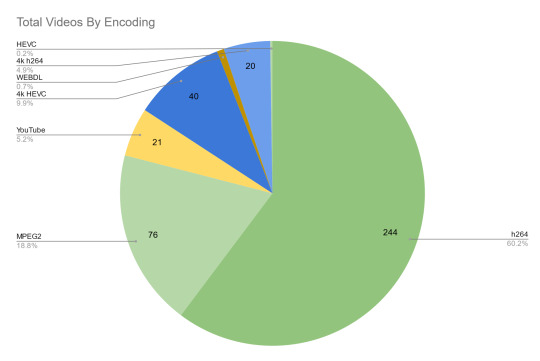
Pseudo research report under the cut (because I'm a massive nerd).
Scope
I started this project with the goal of collecting a full set of "music show performances". I didn't realise quite how ambiguous that definition is. After some deliberation I settled on the following as constituting "regular" performances:
Show Music Core
Inkigayo
The Show
Show Champion
M! Countdown
Music Bank
Simply K-Pop
Everything else I classified as misc. Most notably I left K-Force Special Show in the misc category despite there being quite a few performances on that show in the early days. This mostly came down to how I'm storing the files — I've organised the regular ones by era, but the K-Force Special Show performances frequently happened in between comebacks making them difficult to sort in that fashion. That and difficulties in ascertaining whether I do actually have all of them.
Methodology
The first step in collecting anything is finding out what you need to collect. I was surprised at how difficult it actually is to get a complete list of all of a group's music show performances. There are some fan sites which do a good job of presenting a lot of well categorised individual links to Dreamcatcher's appearances but I was hoping for something more "from the source" (aka the music shows themselves) and ideally machine readable to cross check that nothing is missing, since, for example, a collection of links to all official Inkigayo performance uploads is not a list of all Inkigayo performances (some never got official uploads). I ended up finding /r/kpop's music shows wiki fit my needs the most. The information is all in tables and sorted by music show and date which what I wanted.
Unfortunately, the main tables of /r/kpop's music show wikis only list debuts and comebacks, so I had to index and search all the individual pages to find what I was looking for. This involved spending a couple of afternoons opening up nearly 2,000 tabs of Reddit* and then downloading them using the SingleFile browser extension (Reddit rate limits you quite harshly and so I had to open a bunch of tabs, check they loaded, wait, and then repeat, which slowed it down a lot). While maybe a little overkill I did this for multiple reasons. Firstly, Reddit's search sucks, and I didn't trust it to find all instances of what I was looking for over so many pages. In contrast Everything's in-memory file content index beta is really good. But secondly, this is much more extensible, and now I can find any other group's performances as well (between 2017** and 2023).
*Reddit does not archive Simply K-Pop well at all (which caused some initial confusion), but the official Arirang website works fine as an alternative (albeit one that is somehow even slower than Reddit at opening new pages).
**Reddit's music show wiki pages start right before 2017. This is very convenient for a Dreamcatcher archivist, but, unfortunately for me, curiosity got the better of me and I did venture further out into the unknown. For 2014-2017 I have some scattered archives from various official websites, Twitter accounts, and Korean catch up services. I'm less confident in my music show data for this period in the general case but because the rough start and end dates for the two Minx promotion cycles are known I am confident enough that all the gaps I have in there are genuine gaps and that I'm not missing a performance date.
Once I had my wishlist I then had to go out and, you know, find them. And figure out what "best quality" actually means. I learned a lot about video encoding against my will. I also learned that HEVC is fucking haunted. When multiple sources were available I ranked them as follows:
2160p HEVC > 2160p h264 > 1080p HEVC (one weird edge case I didn't know what to do with) > 1080i h264 > 1080i MPEG2 > WEBDL (usually some kind of web livestream or online catch up service recording) > YouTube
Which I represented in my spreadsheet as:
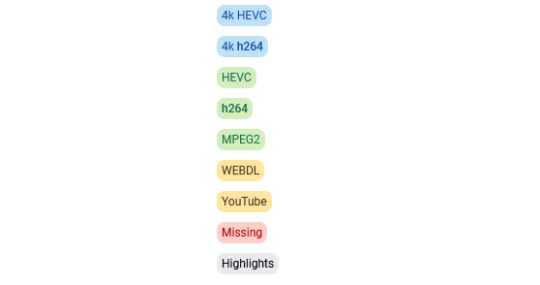
This should be mostly uncontroversial, however, there is a slight complication in that the 4k broadcast copies are not all native 4k but often upscaled from the 1080 source (I can't find specifics on this as the information, if publicly accessible, would be in Korean, and there is only so much Google Translate can do, but the technical broadcasting details probably aren't public to the extend I am interested in regardless so I'm mostly basing this off information gleaned from secondary sources). As far as I can tell there exist two "grades" of upscales: one of which is upscaled by the network before being pushed out to a UHD channel, and one of which is upscaled by the end user by either recording a HD channel in 4k or running an existing recording through an upscaler. Traditionally upscales aren't very desirable due to providing no real material benefit you couldn't get from playing the 1080 copy on a 4k display yourself. Or, for people with an archival mindset like myself, because ones that actually look a bit crisper introduce "magic" pixels which may or may not have ever existed. See below for an example of this taken to the extreme (note the faces):

No one wants that, right? AND YET SOMEONE THOUGHT THAT WAS SUCH A BIG IMPROVEMENT THEY DELETED EVERYTHING ELSE, AND NOW IT REMAINS THE ONLY COPY I CAN FIND. Monsters!!! Anyway.
While upscales usually aren't desirable, I did come around to the idea that the network upscales deserve their place at the top of the list. There are a couple of points working in their favour: one is that they are, presumably, upscaled much more directly from the source, allowing them to avoid some of the data loss that being encoded into 1080i h264 and then upscaled would cause. The second is that quite a lot of them are encoded directly into HEVC, which makes the confetti and flashing lights look noticably smoother than the regular deinterlaced 1080i copies. Also, finally, as a touch of personal preference (especially in the case of 4k h264 where the second point doesn't apply), these do come pre-deinterlaced which is nicer for my chosen method of playback. Although some of those points apply to non network upscales too, the "impurity" of them far outweighs any benefit in my eyes, as I have more faith in whatever the network standard is than some random person on the internet trying to "fix" a file.
So how did I tell the difference? Also a frustratingly difficult problem, one which applies not just to spotting fake upscales but also to finding real TV recordings instead of lower quality catch up service clips. For the 1080 copies one of the biggest things was that the TV broadcast copies (unfortunately) always come through in 1080i. 1080p is suspicious. It means something has been touched (although sometimes in a way that is forgivable when nothing cleaner exists). File sizes are also a good sanity check. A single song in h264 should be in the 200-400MiB range, MPEG2 is 400MiB+. (For reference YouTube, and other inferior WEBDLs, usually come in at under 100MiB). This is a good reminder of why size does not always equal quality, because, in this scenario, worst to best is 100MiB < 450MiB < 250MiB.
On the 4k side: Music Bank, Show Music Core and Inkigayo are currently broadcast on UHD channels with a UHD variant of their channel names in the top right, which is a good indicator that something was recorded from a UHD source. (Although I've found 1080p copies recorded from UHD channels, so the presence of the logo doesn't mean no downscaling has occurred). Recent "4k" M! Countdown, Show Champion and The Show recordings, in comparison, appear identical in channel watermark to the 1080 copies. This and the fact that the only 4k copies I've found are from a source known to dabble in AI upscales means that I'm not going to trust these are genuine without further proof, and this was the main category of files which I decided against adding to my collection. (Note that The Show was in the past the only show that was broadcast in 4k, first on UMAX UHD and then on SBS F!L UHD, it is only recently that that seems to have stopped (or, no one has been recording it)). I paid less attention to the 4k file sizes than for 1080. 4k HEVC seems to come in pretty reliably at just under 1GiB, but 4k h264 is all over the place due to I think some differing quality profiles between uploaders (a range of 1GiB to nearly 3GiB). The latter is annoying because it means I can't figure out what the "true" recording should be, but I did develop an internal ranking of the trustworthiness of sources which was the tiebreaker when two differently sized 4k h264 recordings existed.
I prioritised collecting existing cuts where applicable (although many were not cut nearly as meticulously frame perfectly as I would like) but there were quite a few where I had to cut them out of full broadcast recordings myself. There were also instances where only the main performance was saved in 4k leaving interviews behind. In those cases I decided to keep the highest quality available for the bits in which it was and store the other segments separately.
Results
Alright, the fun stuff! I have successfully catalogued:
317 Dreamcatcher music show performances
34 Dreamcatcher miscellaneous appearances
46 Minx music show performances
16 Minx miscellaneous appearances
Those links go to mostly complete YouTube representations of what I found with exceptions listed in the descriptions of the playlists. You can also of course find a published version of my beautiful spreadsheet here. Finally, if you've made it this deep I would like to just quietly tell you I'm more than happy to share the originals, but please message me privately as I don't want to publicly host questionably copyrighted content on my good and morally upstanding posting images of dreamcatcher photobooks blog (for legal reasons the entire existence of this collection is a joke).
Honestly I'm pretty happy with the completeness of the collection after my first pass. The list of ones I would consider "missing" (aka not good enough quality) is:
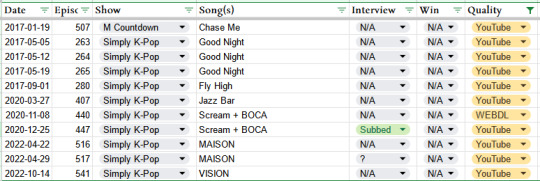
It's almost all Simply K-Pop, which makes sense as it seems to not be archived with the same enthusiasm as the others. The missing M! Countdown, meanwhile, does kind of hurt, since it's ruining an otherwise perfect run. I'm out of ideas for now but am not going to give up on it forever, I have seen evidence that proper recordings exist, so I'm sure they have got to resurface eventually.
As can be seen in the breakdown for this section the percentage of MPEG2 recordings is also a pretty major victory, with the vast majority being h264:
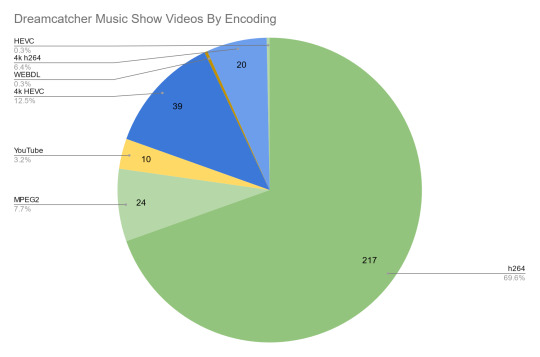
For Minx things look a bit worse:

But then again I hadn't been expecting much to begin with. To be honest, watching all of these to check quality did drive me a little insane. There is a reason I don't own Love Shake and Why Did You Come To My Home, and it's not purely the irresponsible financial decision, it's the thought of spending that much money on something I actually really don't like. Watching Minx performances is amusing for a little while, but man, am I glad Dreamcatcher exists instead.
It's also evident that people were holding to completely different standards even just a few years earlier, as this is where all those MPEG2s in the overall numbers are hiding:
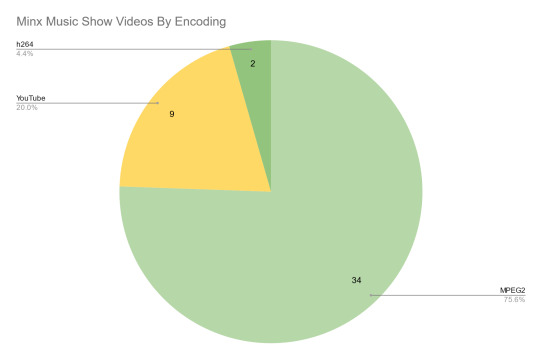
Future Work
While I'm confident I've successfully catalogued the "music show performances" as defined in the scope, I know there is still much more to be discovered under Misc Appearances, as those were filled in not via a predefined wish list but just by what other recordings I happened across in my search for the original goal. The obvious next step would to be a little more systematic about finding out what I'm missing in that category by scouring some Dreamcatcher specific archives, but because I've already exhausted the full collections of my two main sources of recordings I'm not confident I would uncover many more performances outside of YouTube in that way, which isn't really that appealing.
I'm probably more likely going to do something about my performance outfit images collection which has been slowly but steadily increasing over the years. I'd like to put them into a proper searchable database alongside performance dates, which would have a similar effect of cataloguing the missing performances, but with the visual element that the spreadsheet lacks.
But then again, I also might not :)
7 notes
·
View notes
Text
New transistor’s superlative properties could have broad electronics applications
New Post has been published on https://thedigitalinsider.com/new-transistors-superlative-properties-could-have-broad-electronics-applications/
New transistor’s superlative properties could have broad electronics applications
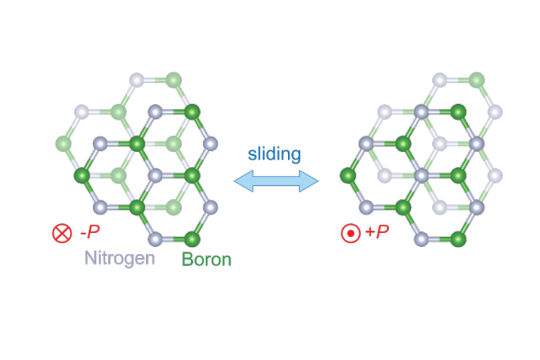

In 2021, a team led by MIT physicists reported creating a new ultrathin ferroelectric material, or one where positive and negative charges separate into different layers. At the time they noted the material’s potential for applications in computer memory and much more. Now the same core team and colleagues — including two from the lab next door — have built a transistor with that material and shown that its properties are so useful that it could change the world of electronics.
Although the team’s results are based on a single transistor in the lab, “in several aspects its properties already meet or exceed industry standards” for the ferroelectric transistors produced today, says Pablo Jarillo-Herrero, the Cecil and Ida Green Professor of Physics, who led the work with professor of physics Raymond Ashoori. Both are also affiliated with the Materials Research Laboratory.
“In my lab we primarily do fundamental physics. This is one of the first, and perhaps most dramatic, examples of how very basic science has led to something that could have a major impact on applications,” Jarillo-Herrero says.
Says Ashoori, “When I think of my whole career in physics, this is the work that I think 10 to 20 years from now could change the world.”
Among the new transistor’s superlative properties:
It can switch between positive and negative charges — essentially the ones and zeros of digital information — at very high speeds, on nanosecond time scales. (A nanosecond is a billionth of a second.)
It is extremely tough. After 100 billion switches it still worked with no signs of degradation.
The material behind the magic is only billionths of a meter thick, one of the thinnest of its kind in the world. That, in turn, could allow for much denser computer memory storage. It could also lead to much more energy-efficient transistors because the voltage required for switching scales with material thickness. (Ultrathin equals ultralow voltages.)
The work is reported in a recent issue of Science. The co-first authors of the paper are Kenji Yasuda, now an assistant professor at Cornell University, and Evan Zalys-Geller, now at Atom Computing. Additional authors are Xirui Wang, an MIT graduate student in physics; Daniel Bennett and Efthimios Kaxiras of Harvard University; Suraj S. Cheema, an assistant professor in MIT’s Department of Electrical Engineering and Computer Science and an affiliate of the Research Laboratory of Electronics; and Kenji Watanabe and Takashi Taniguchi of the National Institute for Materials Science in Japan.
What they did
In a ferroelectric material, positive and negative charges spontaneously head to different sides, or poles. Upon the application of an external electric field, those charges switch sides, reversing the polarization. Switching the polarization can be used to encode digital information, and that information will be nonvolatile, or stable over time. It won’t change unless an electric field is applied. For a ferroelectric to have broad application to electronics, all of this needs to happen at room temperature.
The new ferroelectric material reported in Science in 2021 is based on atomically thin sheets of boron nitride that are stacked parallel to each other, a configuration that doesn’t exist in nature. In bulk boron nitride, the individual layers of boron nitride are instead rotated by 180 degrees.
It turns out that when an electric field is applied to this parallel stacked configuration, one layer of the new boron nitride material slides over the other, slightly changing the positions of the boron and nitrogen atoms. For example, imagine that each of your hands is composed of only one layer of cells. The new phenomenon is akin to pressing your hands together then slightly shifting one above the other.
“So the miracle is that by sliding the two layers a few angstroms, you end up with radically different electronics,” says Ashoori. The diameter of an atom is about 1 angstrom.
Another miracle: “nothing wears out in the sliding,” Ashoori continues. That’s why the new transistor could be switched 100 billion times without degrading. Compare that to the memory in a flash drive made with conventional materials. “Each time you write and erase a flash memory, you get some degradation,” says Ashoori. “Over time, it wears out, which means that you have to use some very sophisticated methods for distributing where you’re reading and writing on the chip.” The new material could make those steps obsolete.
A collaborative effort
Yasuda, the co-first author of the current Science paper, applauds the collaborations involved in the work. Among them, “we [Jarillo-Herrero’s team] made the material and, together with Ray [Ashoori] and [co-first author] Evan [Zalys-Geller], we measured its characteristics in detail. That was very exciting.” Says Ashoori, “many of the techniques in my lab just naturally applied to work that was going on in the lab next door. It’s been a lot of fun.”
Ashoori notes that “there’s a lot of interesting physics behind this” that could be explored. For example, “if you think about the two layers sliding past each other, where does that sliding start?” In addition, says Yasuda, could the ferroelectricity be triggered with something other than electricity, like an optical pulse? And is there a fundamental limit to the amount of switches the material can make?
Challenges remain. For example, the current way of producing the new ferroelectrics is difficult and not conducive to mass manufacturing. “We made a single transistor as a demonstration. If people could grow these materials on the wafer scale, we could create many, many more,” says Yasuda. He notes that different groups are already working to that end.
Concludes Ashoori, “There are a few problems. But if you solve them, this material fits in so many ways into potential future electronics. It’s very exciting.”
This work was supported by the U.S. Army Research Office, the MIT/Microsystems Technology Laboratories Samsung Semiconductor Research Fund, the U.S. National Science Foundation, the Gordon and Betty Moore Foundation, the Ramon Areces Foundation, the Basic Energy Sciences program of the U.S. Department of Energy, the Japan Society for the Promotion of Science, and the Ministry of Education, Culture, Sports, Science and Technology (MEXT) of Japan.
#2-D#affiliate#applications#atom#atoms#author#billion#boron nitride#career#Cells#change#chip#collaborative#computer#computer memory#Computer Science#Computer science and technology#computing#education#electric field#Electrical Engineering&Computer Science (eecs)#electricity#Electronics#energy#engineering#flash#Foundation#Fundamental#Future#green
2 notes
·
View notes
Text

Temporary Temples: Crop Circles, Sacred Geometry, and Spiritual Awakening
Crop circles are not simply random flattened areas in fields; they are complex works of art that often exhibit astonishing complexity and precision. These formations can range from simple circles and rings to elaborate geometric patterns, complex fractals, and even detailed depictions of animals, celestial bodies, and symbolic shapes. The sheer variety of designs is remarkable, and each season brings new and unexpected creations.
One of the most fascinating crop circle formations is the 2001 Chilbolton case, documented by Karen Alexander and her team. This formation consisted of two parts: a "face" and a "message". The "face" was a detailed depiction of a human-like figure with large eyes and a distinctive shape, resembling the famous "grey" alien archetype. Alongside it, the "message" was encoded in binary code, which, when decoded, appeared to be a response to the 1974 Arecibo message, sent into space as a demonstration of human intelligence. This formation not only demonstrated the complexity of crop circle designs, but also pointed to a possible extraterrestrial intelligence behind the phenomenon.
Karen Alexander and her husband Steve have revolutionised the documentation of crop circles through their innovative use of aerial photography. By capturing the formations from the air, they have revealed the full magnificence and grandeur of these patterns, allowing a comprehensive understanding of their geometry and structure. Aerial photography provides a unique perspective, revealing the intricate details and overall layout of crop circles. But their research doesn't end there. Karen and her team also carry out careful surveys on the ground, gathering important data and insights. They take soil samples, measure electromagnetic fields and examine the physical properties of the plants involved. This multi-faceted approach allows them to uncover potential clues to the formation process and any anomalies present in the environment. For example, some crop circles have shown signs of unusual heating or changes in the molecular structure of the plants, suggesting the involvement of unknown forces.
One of the most fascinating aspects of crop circles is their frequent occurrence near ancient sites and sacred landscapes. Many formations have been discovered in close proximity to Neolithic monuments such as Stonehenge and Avebury in the United Kingdom. This connection with ancient wisdom and sacred geometry has led researchers such as Karen Alexander to investigate the spiritual and cultural significance of crop circles. The designs often incorporate elements of sacred geometry, a universal language of symbolism and spirituality that has been present in various cultures throughout history. The alignment of crop circles with ancient sites suggests a deeper connection with the land and the potential of these formations to act as temporary temples inviting contemplation and spiritual experiences. This aspect of the phenomenon adds a layer of mystery and intrigue, raising questions about the intentions and origins of the creators of the crop circles.
The connection between crop circles and UAPs is a major aspect of Karen Alexander's research. Numerous eyewitness accounts report strange lights or UAPs near crop circles before or during their formation. These sightings often involve silent, glowing spheres or disks that move in ways that exceed the capabilities of conventional aircraft. The extraterrestrial hypothesis that UAPs may be responsible for the formation of crop circles is further supported by the complexity and precision of the formations. If UAPs are indeed involved, this implies the presence of an advanced intelligence capable of manipulating the environment in extraordinary ways. This theory raises profound questions about the nature of these UAPs, their intentions, and the potential to communicate with an extraterrestrial civilization.
Crop circles have a profound effect on those who encounter them firsthand. Karen Alexander has spoken extensively about the transformative experiences people have in these formations. Visitors often report feelings of awe, peace, and a heightened sense of connection with the universe. Some individuals claim to have experienced spiritual awakenings or profound insights in crop circles. The idea that crop circles serve as temporary sacred places, or "temporary temples," as Karen Alexander calls them, invites us to reflect on the potential of these formations to facilitate spiritual experiences and personal growth. The sense of wonder and mystery that surrounds crop circles encourages people to reflect on their place in the cosmos and their relationship to the natural world.
One of the ongoing challenges in crop circle research is the skepticism and misconceptions that surround the phenomenon. Many people dismiss crop circles as a hoax or the work of pranksters without considering the vast body of evidence that suggests otherwise. To address this problem, Karen Alexander and her team focus on rigorous scientific research, collaborating with experts from various fields, and communicating openly with the public. By presenting their findings transparently and engaging in dialogue, they aim to dispel misinformation and encourage critical thinking. In books, documentaries, and public lectures, they share their experiences and findings, allowing others to form their own opinions based on the available evidence. This approach helps to promote a more informed and open-minded discussion about crop circles.
Karen Alexander (UAP Files Podcast, October 2024)
youtube
Monday, October 14, 2024
#crop circle research#aerial photography#sacred geometry#ancient sites#spiritual experiences#ai assisted writing#machine art#interview#Youtube
6 notes
·
View notes
Text
Tales of the Rays: Mirrage Prison

Chapter 6: The Atoning Hero and Remorseful Chosen (Part 1 & 2)
(This is the first part!) | (Part 3)
So, I've been meaning to upload this for a while. I don't really have any excuses for how long it took me. This covers Kratos investigating the Asgard Empire, only to find out that Mithos has been exoflected and has "gone on a rampage".
Part 1 (Spirit Research Lab)

Kratos: (Is this a…spirit research facility?) (ここは……精霊の研究施設か?)
Kratos: (I had no idea the Imperial City had something like this near the Imperial Lotus Villa…) (帝都の芙蓉離宮の近くにこんな研究室を作っていたとは……。)
Kratos: (No wonder I haven’t seen Demitrius in Asgard Castle.) (どうりでアスガルド城でデミトリアスの姿を見かけない訳だ)

Demitrius: How is the investigation of the Nexus Subspecies 03's anima progressing? 特異鏡映点亜種03のアニマの調査はどうなっているのかな?
Junior: …Well, Spada's anima still has traces of having been a living weapon. ……確かにスパーダさんのアニマには武器として生きていた痕跡が残っていました。
Junior: It might be that the anima of his previous life is muddled with his current anima due to the encoding at the time of exoflection. 前世のアニマが具現化の時のエンコードで現在のアニマと混濁しているみたいです。
Richter: Perhaps in Spada’s previous life, he was similar to the Swordian Chaltier. The one owned by Leon. もしかしたらスパーダの前世というのはリオンという奴が持っていたシャルティエと言う剣と似た存在だったのかもしれない。
Richter: It isn’t exactly the same, but it should be find to treat them similarly: both are weapons with human-like wills. 正確には違うことはわかっているが武器であり人のような意思を持つという点は近いものとして扱ってもいいだろう。
Junior: We’ve come up with a plan to exoflect both the relevant technology and experts in this field from Leon’s world. リオンさんたちの世界から、該当の技術を、持っている専門家を具現化するという計画が持ち上がっています……。
Kratos: (Chaltier is that talking sword Zelos told me about. Why do they have such an obsession with talking weapons…) (シャルティエと言うのはゼロスが話していた喋る剣のことか。何故命を持つ武器に固執するのだ……。)
Demitrius: That so…? Then let's have Richter and Aster report on their ongoing research on spirits. そうか……。ではリヒターとアステルが進めている精霊の研究の方を報告してもらおうか。
Richter: I won’t bring Aster here. I’ll do my report alone. アステルをここへ連れてくるつもりはない。報告は俺がする。
Demitrius: I know you're wary of me, but I'm not going to do anything to Aster. 警戒されているようだが私はアステルに何もしないよ。
Demitrius: If I wanted to do something to him, I would have done it already. There's been plenty of opportunities. どうにかするつもりならとっくに捕らえている。機会はいくらでもあるからね。
Demitrius: After all, I hear he's been going out a lot without you watching. 何しろ彼はきみの目を盗んでよく出歩いているそうじゃないか。
Demitrius: You had a difficult time looking for Aster the other day, I heard. この間も大変な剣幕でアステルを捜していたらしいね。
Richter: …You’re certainly different from Mercuria. Speaking of, you’re too lenient with her. ……お前はそうでもメルクリアは違う。貴様はメルクリアに甘すぎる。
Richter: I don’t want Aster to end up like Ami. 俺はアステルをアミィのようにしたくはない。
Demitrius: It hurts my heart to hear you say that. Well, we can talk about this more some other time. それを言われると心が痛むよ。まあ、その話は別の機会にしようか。
Demitrius: To protect the Void, we need the power of the sun god Dana and the spirits. I have high hopes for your research. 虚無の保護のためには太陽神ダーナと精霊の力が必要だ。君たちの研究には期待をしているんだよ。
Demitrius: Every one of our plans for Dana has failed so far. Dist is absorbed in his own strange obsessions. We should focus on finding Dana’s priestess. ダーナを降ろす計画にも悉く失敗している。ディストは妙なこだわりも強い。ダーナの巫女を見つけた方が早いと思うんだよ。
Demitrius: Dana’s priestess should be the most suitable vessel for Dana. ダーナの巫女こそダーナの器にもっとも適する筈だからね。
Richter: The literature Aster and I found had something to say about her. 俺とアステルが見つけた文献にはこう書かれていた。
Richter: Aifread protects Dana’s priestess alongside Origin in a place where the spirits were sealed away. アイフリードが精霊の封印地なる場所でオリジンと共にダーナの巫女を守っているのだと。
Richter: We haven’t pinpointed this place’s location yet, but I doubt it will be easy to get to. It’s entirely possible it’s already been obliterated by the Voidstorm. 場所の特定はまだだが簡単に行ける場所ではないだろう。死の砂嵐で消滅している可能性もある。
Demitrius: No, it is not limited to the place where the spirits reside. If the place where the spirits dwell collapsed, this world would be completely consumed by the Void. いや、精霊のいる場所に限ってそれはない。精霊住まう場所が崩壊すれば、この世界は完全に虚無に飲まれているだろう。
Richter: If this sealed land of spirits still exists, the Nexus you ordered Hasta and Saleh to bring back will be useful. もしまだ精霊の封印地が存在しているなら貴様がサレとハスタに命じて回収に行かせた例の鏡映点が役に立つだろう。
[ Saleh and Hasta immediately enter lol ]

Saleh: You wanted to see us, Richter? 呼んだかな、リヒター君。
Hasta: I’ve found our bon. Our hollow little Maxwell! 見つけたボン。空っぽのマクスウェルちん!
Kratos: (A hollow Maxwell…? But the Maxwell of this world hasn’t woken up yet. Maybe he means that Milla character who was with Lloyd and the others.) (空のマクスウェル……?この世界のマクスウェルはまだ目覚めていないがロイドたちの元にいたミラのことか?)
Kratos: (No, that doesn’t make sense. He said “hollow”…) (いや、しかし『空』というのは……)
Richter: …Since these people are here, I’ll be excusing myself. ……こいつらが戻ったなら、俺は失礼する。
Saleh: You hate me, huh? Well, I’d prefer that snot-nosed lizard who never stops crying “Jade~ Jade~”. 嫌われたもんだね。僕はジェイドジェイドとうるさいあの鼻たれトカゲよりキミの方がマシだけれど。
Asgard Soldier: We’ve got trouble! One of the four Phantom Generals is rampaging through Dist the Reaper’s lab! It’s Mithos! 大変です!四幻将のミトス様が死神ディストの研究所で暴れて、手がつけられません!
Asgard Soldier: Dist is critically injured, Shing is hurt, too, and not even Caius can stop him! ディストは重傷、シング様も負傷しカイウス様ですら近づけない状態です!
Kratos: (—Mithos is rampaging!?) (——ミトスが暴れている!?)
Hasta: Whaaat? Sounds like there’s an opportunity for bloodfeeding… Let me join in! 何ィ!血沸き肉躍る饗宴の宴だと……オレっちも参加させろぃ!
Saleh: Shall I kill him? 僕が殺してこようか?
Demitrius: Stay out of it. I still want to ask you both about Maxwell’s empty shell. Richter, you can stop Mithos, right? やめておく方がいいね。それに君たちにはマクスウェルの抜け殻の件を聞きたい。リヒターならミトスを止められるだろう?
Richter: …I don’t know, but it’s better than saying here. I’ll be going. ……分からんが、ここにいるよりはマシだ。俺が行く。
Kratos: (It's time to meet up with Mark and the others, but I can't leave Mithos alone. …I’ll follow behind Richter.) (そろそろマークたちと落ち合う時間だがミトスを放っておくことはできぬな。……リヒターを追跡させてもらおう)
Part 2 (6-2 Spirit Research Lab 2)

Zelos: That old man seriously hasn’t gotten back to the rendezvous point yet!? あのおっさんまだ合流地点に戻ってこないのかよ!?
Mark: Hey, hey, Zelos. Don’t you think you’re too hard on Kratos? He’s a nice guy. おいおい、ゼロスさんよ。あんた、クラトスにはあたりがきついな。あの人、いい人じゃねえか。
Zelos: Haaah? You, too, Markun? It’s sickening how many people like that guy. はー。お前もか、マーくんよ。あいつホント受けがいいな、むかつくわー。
Zelos: People say he’s so coool~, but he’s just a bastard! ク~ル~とか言われてるけどありやただの人でなしだっつーの!
Sync: Heh… へえ……。
Zelos: Ah, Sync!? Did you just laugh at me, just now!? あ、シンク!?てめえ、笑ったな!?
Sync: That’s right. You’re just a spoiled redhead. Do you miss your daddy, oh great Chosen? そりゃ唯うでしょ。アンタのそれは単なる甘えだからね。パパが恋しいのかい、赤毛の神子様。
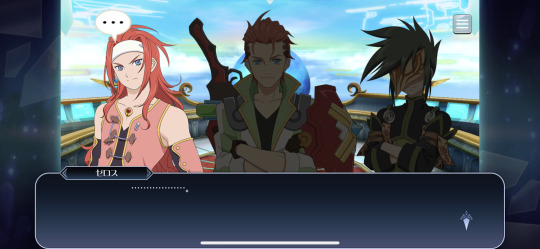
Zelos: ………。
Mark: Sync, please don’t go around digging into people’s wounds like that. シンク。そうやって的確に人の傷抉っていくのもほどほどにしてくれや。
Mark: Zelos, I’m sorry. Kids don’t know how to hold themselves back. ゼロス、悪かったな。子供は加減をしらねえんだよ。
Zelos: …No, I’m not ready for this yet. Sore spot or not, I can’t believe I got so serious when I don’t even know this kid. ……いや、俺さまもまだまだだわ。殆ど面識のないがきんちょに痛いとこ突かれてマジになっちまうとは。
[ Phillip Enters ]

Phillip: Sounds like you’re having fun. I hope I’m not interrupting. 楽しそうなところ失礼するよ。
Zelos: Fun!? Phil, you really think this looks like fun? 楽しい!?俺さまフィル君の感覚疑ってもいい?
Phillip: Sorry, sorry. I thought I’d pop in and share how our patient is doing. ごめんごめん。病人の経過を共有しようと思って。
Sync: You mean that dying old geezer and our log of a Sleeping Beauty? 死に損ないのジジイとぴくりとも動かない眠り姫のことか。
Phillip: You shouldn't call him an old geezer, Sync. In any case, Rowen is much more stable now. ジジイなんて言葉は良くないよ、シンク。ローエンさんはだいぶ安定してきた。
Phillip: I think he’s going to wake up soon. Still, he’s an omega nexus, so we’ll have to monitor him carefully. もうすぐ起きられると思うけれど何しろ特異鏡映点だからね。慎重に経過を見る必要がある。
Phillip: And Kohaku…she’s quite dangerous, to be honest. それからコハクは……正直かなり危険だね。
Zelos: Hey hey hey, I don’t care about the old man, but we have to help the girl out~! おいおいおいおい、じーさんはともかく女の子は助けてやってくれよ~!
Mark: You guys, we should be taking care of the elderly… Well, Phil, tell us what’s going on with Kohaku. She seemed stable to me. お前ら、お年寄りは大事にしろって……。で、フィル。どういうことなんだよ。容体は安定してるように見えたけどな。
Phillip: Her symptoms look like a rare condition that appears in mirrites. I found that curious, so I approached it from a mirristry perspective. 彼女の症状は鏡士にまれに起こるある疾患に似ていてね。気になったから魔鏡学の方向からアプローチしてみたんだ。
Phillip: As a result, I’ve discovered that she’s lost her core, or heart, which is responsible for connecting one’s anima to their animus. その結果、彼女のアニマとアニムスをつなぐコアつまり心を失っていることがわかった。

Mark: She’s lost her core!? 心核喪失状態か!
Sync: What are you talking about? How can you possibly observe something as vague as a “heart”? 何それ。心なんてあやふやなものどうやって観測するのさ。
Mark: Mirrites are reflections of a mirrist’s heart. At the time of exoflection, it’s…able to be briefly observed. 鏡士ってのは、心を魔鏡に映して具現化を、行うんだ。そのときに一瞬心を具現化している……らしい。
Mark: I don’t exactly get the whole principle behind it, either… そのあたりの原理は俺もよく分からないが……。
Phillip: When a mirrist exoflectes a mirrite, they do so by reflecting a portion of their heart into their mirrage. So to speak, mirrites are exoflections of the heart. 鏡士が鏡精を具現化するときも心の一部を魔鏡に映して行ういわば心の具現化だからね。
Phillip: But Kohaku does not have a heart. でもコハクにはその心に当たる部分が存在しないんだ。
Phillip: If her core doesn’t exist, her anima and animus will separate…meaning, her soul and memories will separate, and her body will not be able to maintain itself. This is exceptionally dangerous. コアが存在しなければアニマとアニムス……つまり魂と記憶が分離し体が保てなくなる。非常に危険だ。
Phillip: Perhaps it’s necessary to erase the heart in order for them to become the vessel of the goddess. 神降ろしには心を消し去る作業が必要なのかもしれないね。

Zelos: …Erasing the heart, huh. Reminds me of Collete. ……心が消える、か。コレットちゃんのことを思い出すな。
Zelos: She lost her sense of humanity in order to become a host for Martel, she lost her heart. I couldn’t stand watching her, she was like a doll. マーテルを宿すために人としての感覚を失って、心まで無くしちまったらしくてな。まるで人形みたいで見てられなかったぜ。

Sync: —Hey, it’s possible that this whole goddess vessel plan is Mithos’ idea. ——ねえ、神降ろしはミトスの発案の可能性があるんだったよね。
Zelos: Ah? Well, it sounds possible. The idea’s pretty similar to the way he wanted to revive Martel. あ?まあ、可能性はあるな。発想がマーテル復活にそっくりだ。
Sync: —Let’s meet up with Kratos. I’ve figured out which nexus they’ll pick as the next vessel. ——クラトスと合流しよう。次の器の鏡映点が誰かわかった。
Mark: What do you mean? どういうことだ?
Sync: From what I’ve heard, Colette was in some way close to Mithos’ sister, Martel. 前に聞いた話だと、コレットってのはミトスの姉のマーテルに近い存在だったんだろ。

Zelos: Are you saying Martel is their next vessel!? Well, I had heard that Phantom had exoflected her while he was still around. まさかマーテルが次の器だって言うのか!?そりゃ、ファントムが生前マーテルを具現化したらしいとは聞いてるけどよ。
Zelos: Yeah, Martel and Colette are close, but Martel never lost her heart. ただコレットちゃんとマーテルは近い存在かもしれないがマーテルは心を失った訳じゃねえぞ。
Zelos: Actually, she only had her heart left, so Mithos was trying to get her a body… むしろ心だけになっちまったからミトスが体を作ろうとしてた訳で……。
Phillip: …No, I see what he’s saying. Sync’s as sharp as ever. ……いや、なるほど。さすがシンクは目の付け所がいいね。
Phillip: The fact that Martel is a being who lost her body and became only a heart is…an important fact. マーテルは体を失い、心だけの存在になったことがある……という事実が重要だ。
Phillip: In the past, Bifrost had a mirrage called the Overray Mirrage—which showed the past and possible futures engraved in one’s anima. かつてのビフレストには、アニマに刻まれた、過去や未来——あらゆる可能性を呼び出す浄玻璃鏡という魔鏡があったそうだ。
Phillip: This means that no matter which era Martel was exoflected from, she has a property that makes it easy to separate her body and heart. つまりマーテルがどの時代から具現化されていたにせよ、体と心が分離しやすい性質を内包していることになる。
Phillip: If they can be separated, the rest is simple. 分離できるなら、話は簡単だ。
Zelos: You can’t be serious… We should let Kratos know just in case. マジかよ……。念のためクラトスに伝えるか。
Zelos: We should look for that trail Angel wings leave behind. If he flies with his wings, we’ll be able to spot it. あいつから聞いた、天使の羽の痕跡を辿る方法ってのを使えば、奴が空を飛んだ時に居所がわかる筈だ。
Mark: I’m sorry. You’re our guest and we’re making you work. 悪いな。あんたは客分なのに、こき使っちまって。
Zelos: Oh well. That selfish Angel doesn’t want me hanging out with Lloyd anyway. しゃーねえな。あの我が儘天使がロイド君に合流するのを嫌がるんだもんよ。
Sync: You complain about that, but you never bother joining Alvin when he sneaks over there. でも文句を言いながら、アルヴィンみたいに一人であっちに合流はしないんだね。
Mark: Well, that’s because Zelos is unexpectedly a good guy—and also unexpectedly a coward. そりゃ、ゼロスが意外と善人な上に意外と卑怯者だからだな。

Zelos: Ehehe, you completely understand me. でひゃひゃ、よくわかってるじゃねーの。
Mark: But, that doesn’t change the fact that you’re our guest. Sync, you’re coming with me. とはいえ、あんたが客分なのは変わらないからな。シンク、一緒に行ってくれ。
Sync: …Yeah yeah, what a pain. ……はいはい、めんどくさ。
Zelos: What is it, Synkun? You’re so cold. 何だよ、シンくん冷たいじゃん。
Sync: I’ll kill you, Idiot Chosen. 殺すよ、バカ神子。
(This is the first part!) | (Part 3)
#tales of the rays#totrays#kratos aurion#richter abend#saleh#zelos wilder#marcus grimm#sync the tempest#phillip reston#phillip biqe reston#nix translates
10 notes
·
View notes
Text
'Encoder' Zim AU Idea Thingy
ie, Cas is Trying to World Build this Invader Zim AU he wants Alicia and Steven to Write and the whole process has got him like this:
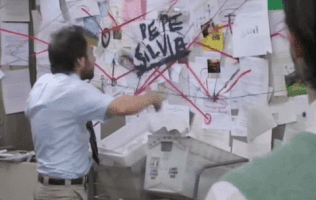
Putting the idea behind a cut but also tagging @paynomindtotheinsanity because this was heavily inspired by a conversation we had a few days about competent!Zim but also because her characterization of Zim is *chef's kiss* in Your Eyes Are Red.
So the real concept is that instead of “Invading” planets, Irkens are sent to various alien planets throughout the universe in order to study them. And then they “assimilate” them into the Irken Empire’s vast galactic Empire.
The Irken Race are being guided by the “Control Brains” still – the Control Brains can do all the things that they can totally do in like – The Trial episode. But also note that Red (Savin) and Purple (Jazz) (like 00 version J&S where they are very, very sexually compatible but not necessarily compatible-compatible, especially as leaders, not that it matters because –) are basically puppet dictators – they know their role is just to be the public face for the Control Brains.
The thing is – the Control Brains aren’t actually Irken. They’re humans who achieved immortality. I want to say two of them but honestly? I think they’re supposed to be the 8 richest human beings from this earth. They had so much wealth and power that they basically other humans into something unrecognizable…
Well, they turned them into Irkens.
Irkens are basically the like, Worker Bees of the giant Hive Mind the Control Brains worked really hard to create, and have been creating, for the past millennia. Irkens are used to MAINTAIN the hive. They go to planets and figure out what sorts of things its societies are doing “wrong” and how fractured each world is etc and learn the history / record the issues down and then pass the information to The Tallests. The Tallests then report this information to the Control Brains, who then decide the fate of those planets.
(Read: The Control Brains then tell the Tallests that yes, these planets should be assimilated and that they need sooooo much help and guidance to learn how to have the besttttt livessssss ever and like…. the Encoders are supposed to facilitate that whole process, as well. Irkens live for many many years, they effectively don’t age because they’re genetically perfect, thanks to the cloning process, and the Paks make sure that everyone stays in LINE)
So rly – Paks keep Irkens Alive, they keep them In Line, and they essentially act as fucking thought police.
Now – here’s where it’s gonna get a bit loopy.
Irkens are Humans, right? The first race that the Control Brains assimilated into the Hive Mind? The same Hive Mind that essentially continues to feed the Control Brains desire to control EVERYTHING across the galaxy and continue to pile more and more money etc???
What happens if an Irken Encoder is sent, purposely, to Earth?
Humans shouldn’t still exist, right?
Yeah, tell that to planet Earth, circa year 2001. Humans are still there. Still “thriving.”
Professor Membrane is studying Human Genetic Manipulation. He’s made two clones of himself – a boy, and a girl. They’re both him, they’re his kids, they’re fucked up. As all families are.
Professor Membrane is also splicing Human Genetic Material with Other Species’ Genetic Material.
Except he can’t test this shit on HUMAN subjects, because that shit’s unethical.
Well…
Except he can, though.
He proved that he could clone himself, after all. Who’s to say he can’t just…. try to clone humans and manipulate their DNA that way? No one. He’s given free fucking rein because Dib and Gaz were the only “successful” human clones he’d produced, according to his research and the grants etc he was given to conduct this research, etc.
Dib and Gaz may get to live long, happy lives (as they are human beings born with Privillege – Professor Membrane’s rich as fucking hell, obvs) – but they have an untold number of “siblings” they know nothing about.
I can’t remember if it was Enter the Florpus that had Membrane working on a perpetual motion / energy machine? I think it was Enter the Florpus.
Anyway, EtF more or less proves that the Earth IZ takes place on is part of a series of different AUs. Remember, there are other dimensions, too – A Room With A Moose, for example. So this isn’t all that weird of a thing.
Thing is, these AUs exist together and overlap one another and Zim is sent to Encode Earth. Zim is a competent Irken Encoder; he has yet to fail at properly folding various planets in. He’s good at it. It essentially requires him to just conduct experiments on different races all day long and see how they work etc.
He’s so good at it, he starts to notice weird shit about the Human Race, and about the planet in general. Features of it look familiar; bits of history sound familiar, etc.
btw, he and Dib more or less have the SAME weird rival situationship happening – because Dib recognizes Zim as not a human being (“Does…. nobody see the alien sitting in class?”), and since Zim is competent at blending in and shit (and honestly? Yeah, he kinda IS in the show – at least with middle schoolers? he was REAL GOOD at getting the other kids to be on his side and not Dib’s).
So Dib grew up the same fucking pariah in his class, with Zim like – falling into the “preps” – Drumline Captain for the marching band, etc. Like, Zim is popular. The girls want to date him. The boys want to be him, etc. Prom King material, right there.
They graduate.
They go their separate ways. Dib becomes a paranormal investigator with the CIA (Swollen Eyeballs - Agent Mothman) and…
Well, he’s given a mission to assassinate a certain scientist / researcher. Someone who’s putting too many puzzle pieces together and therefore threatens to completely collapse the human race and, quite honestly, the planet – especially if he ever gets his research published. Because this scientist / researcher has been working independently for at least a decade, and every single time he releases findings, Things Happen.
The researcher / scientist / historian (lol) is Zim.
Chaos ensues.
#encoder Zim AU#yes that's what I'm calling it#I thought about 'enforcer' Zim but this feels less... something#like they're still Invaders they've just#given them a less obvious name for these 'soldiers'?#Invader Zim#Invader Zim AU#world building#idk man it's epic and I needed Cas to give me the backstory so I could properly start it#yes it's gonna be ZADR#I was given the advice to get back to my roots as a writer#Invader Zim are my roots
5 notes
·
View notes
Text
Interesting Papers for Week 23, 2025
Exploring replay. Antonov, G., & Dayan, P. (2025). Nature Communications, 16, 1657.
Excitation-Inhibition Balance Controls Information Encoding in Neural Populations. Barzon, G., Busiello, D. M., & Nicoletti, G. (2025). Physical Review Letters, 134(6), 068403.
Persistent effects of salience in visual working memory: Limits of cue-driven guidance. Constant, M., & Kerzel, D. (2025). Journal of Experimental Psychology: Human Perception and Performance, 51(2), 153–163.
Prediction of intrinsic and extraneous cognitive load with oculometric and biometric indicators. Ekin, M., Krejtz, K., Duarte, C., Duchowski, A. T., & Krejtz, I. (2025). Scientific Reports, 15, 5213.
Electrophysiological signatures of the effect of context on exploration: Greater attentional and learning signals when exploration is costly. Ferguson, T. D., Fyshe, A., & White, A. (2025). Brain Research, 1851, 149471.
Normative and informational confidence matching. Friedemann, M., Bang, D., & Yeung, N. (2025). Journal of Experimental Psychology: General, 154(3), 759–774.
Goals bias face perception. Hu, Y.-F., Heffner, J., Bhandari, A., & FeldmanHall, O. (2025). Journal of Experimental Psychology: General, 154(3), 644–657.
A systems model of alternating theta sweeps via firing rate adaptation. Ji, Z., Chu, T., Wu, S., & Burgess, N. (2025). Current Biology, 35(4), 709-722.e5.
Perceived Multisensory Common Cause Relations Shape the Ventriloquism Effect but Only Marginally the Trial‐Wise Aftereffect. Kayser, C., & Heuer, H. (2025). European Journal of Neuroscience, 61(3).
Atypical hippocampal excitatory neurons express and govern object memory. Kinman, A. I., Merryweather, D. N., Erwin, S. R., Campbell, R. E., Sullivan, K. E., Kraus, L., Kapustina, M., Bristow, B. N., Zhang, M. Y., Elder, M. W., Wood, S. C., Tarik, A., Kim, E., Tindall, J., Daniels, W., Anwer, M., Guo, C., & Cembrowski, M. S. (2025). Nature Communications, 16, 1195.
Visual simulation and subjective probability estimation: When seeing is believing. Kirshner, S. N. (2025). Decision, 12(1), 31–42.
Recurring suboptimal choices result in superior decision making. Mondal, S., Lenda, D., & Traczyk, J. (2025). Decision, 12(1), 63–91.
A non-Hebbian code for episodic memory. Pang, R., & Recanatesi, S. (2025). Science Advances, 11(8).
Reinstatement and transformation of memory traces for recognition. Rau, E. M. B., Fellner, M.-C., Heinen, R., Zhang, H., Yin, Q., Vahidi, P., Kobelt, M., Asano, E., Kim-McManus, O., Sattar, S., Lin, J. J., Auguste, K. I., Chang, E. F., King-Stephens, D., Weber, P. B., Laxer, K. D., Knight, R. T., Johnson, E. L., Ofen, N., & Axmacher, N. (2025). Science Advances, 11(8).
Action consequences guide the use of visual working memory. Sahakian, A., Gayet, S., Paffen, C. L. E., & Van der Stigchel, S. (2025). Journal of Experimental Psychology: Learning, Memory, and Cognition, 51(1), 4–13.
Orthogonal neural representations support perceptual judgments of natural stimuli. Srinath, R., Ni, A. M., Marucci, C., Cohen, M. R., & Brainard, D. H. (2025). Scientific Reports, 15, 5316.
Higher order affordances. Stoffregen, T. A., & Wagman, J. B. (2025). Psychonomic Bulletin & Review, 32(1), 1–30.
Memory modeling of counterfactual generation. Wang, F., Aka, A., He, L., & Bhatia, S. (2025). Journal of Experimental Psychology: Learning, Memory, and Cognition, 51(2), 255–284.
Latent memory traces for prospective items in visual working memory. Xu, L., Sahakian, A., Gayet, S., Paffen, C. L. E., & Van der Stigchel, S. (2025). Journal of Experimental Psychology: Human Perception and Performance, 51(2), 164–177.
Rational choices elicit stronger sense of agency in brain and behavior. Yavuz, M., Bonicalzi, S., Schmitz, L., Battich, L., Esmaily, J., & Deroy, O. (2025). Cognition, 257, 106062.
#neuroscience#science#research#brain science#scientific publications#cognitive science#neurobiology#cognition#psychophysics#computational neuroscience#neural computation#neural networks#neurons
5 notes
·
View notes
Text
covid and mental health
By Rachel Shannon
Everyone can relate to the fact that covid was a stressful period in our human existence. Some people struggled more than others but no hardship should be weighed or compared to one another's. It was both a tribulation and a learning experience. Before covid, we lived in a very rushed Society. The work day was 9-5 Monday through Friday, we never thought to challenge it. Now post covid, some people don't work on Mondays or have half a day on Fridays, or some people work completely remote which never used to be an option. We now take more time for our emotional health and embrace therapy which for decades previously was considered taboo. To get to this point, Society had to face some tough adversities which include mental health decline in Victoria Australia, harsh discriminatory challenges for Asian Americans, and radical transitions for college students. These three scenarios are just a few examples of some of the many ways in which covid impacted our mental health. These situations brought awareness to the way we view and treat mental health.
Since covid, intentional self-harm rates skyrocketed in Victoria Australia due to lack of employment opportunities and social isolation. While young people are less susceptible to covid, the pandemic did disproportionately affect their psychosocial development, as social connectedness and social identity are important factors in youth. Suicide attempt hospitalization rates ranged from 77.4 to 97.9 events per 100,000 population between 2012-2013 and 2019-2020. Rates were higher outside of urban areas. It is estimated that the self-harm hospitalization rates in Greater Melbourne was 75.9 per 100,000 population compared to 112.0 per 100,000 population in the rest of Victoria. The Victorian mental health system was extensively evaluated by the Royal Commission on the advice of the Victorian government. The Royal Commission found that the state's mental health system was unable to respond to the needs of the people suffering from mental illness or psychological distress, unsuitable to meet current and future demands, and an urgent need for reform.
“Pre-existing individual factors, such as poorer physical health, a history of chronic illness, or pre-existing mental health problems, have been associated with higher rates of anxiety and depression during COVID-19. Other individual factors may be important too, for example introverted individuals are somewhat less likely to have high quality social support systems compared to extraverts. Consistent evidence shows that adults experiencing pre-existing socio-economic disadvantages face increased mental health problems related to COVID-19.” (Westrupp,”et al.”2023)
While Westrupp explains that pre-existing conditions occurred in parents and children in Victoria before covid, these conditions were made worse from government restrictions and shutdowns.
Since covid, the Asian-American population have faced intense racial discrimination which include verbal harassment and physical assault. This is mainly due to media outlets blaming China for the pandemic. A recent Pew Research Center report found that approximately 31% of Asian American adults reported being the subject of slurs or jokes because of their race or ethnicity, and about 58% of Asian American adults shared that it is more common for people to express racist or racially insensitive views about Asians than it was before the covid-19 outbreak. The increase in racial discrimination against Asian Americans during the covid-19 pandemic has also contributed to covid-19 discrimination fear, which exacerbated mental health problems such as depression and anxiety.
“Anti-Asian racism has always been present in the US society for over 150 years, though it has been encoded in different vocabulary and language in different periods of time.”(Adachi,2022).
Adachi explains that the “Yellow Peril” which is described as western fears of Asians, especially Chinese, would invade their land and disrupt western values, started as far back as the 1870s. Although these fears already existed, there has been an uptick in racial discriminatory acts since covid due to media outlets and politicians.
Covid took a strain particularly on college students. College is already a stressful time for young adults then covid added the pressure of social distancing, working remotely and in extreme cases leaving their dorm and finding residence elsewhere. Many may argue that stress among college students is unrelated to covid and that it’s been an ongoing issue for some time. McLafferty writes that a survey was conducted of students who attended college in Northern Ireland in the fall of 2019, then again a year later found that high levels of mental health problems were already present among students commencing college. Although college students were already struggling before the pandemic, it’s important to understand that covid exacerbated pre-existing mental health conditions.
“Students assessed post pandemic reported significantly more symptoms of anxiety and depression than students assessed pre pandemic, and these two cohorts are reporting more symptoms in many areas than a cohort of students assessed 25 years earlier.”(Nails,2023).
In conclusion, the COVID-19 pandemic made the Victorian government aware of the urgent need for better mental health care for their people, brought to light the racial injustice of Asian-Americans, and showed the massive strain covid had on college students. These three situations highlight the severity in which covid affected our mental health. After the pandemic, it was realized that mental health care was at the bottom of the list of priorities. This awareness led to changes such as flexible working conditions and more need for therapy. Therapy also became more available remotely. Not only should we spread awareness on the issue of mental health but we should also take combative steps to help such as make therapy more affordable and hire more mental health providers. Unfortunately it took this catastrophic event to make us open our eyes. With this better awareness and understanding, we as a society can tackle mental health issues head on.
Vacher, C., Ho, N., Skinner, A., Robinson, J., Freebairn, L., Lee, G. Y., Iorfino, F., Prodan, A., Song, Y. J. C., Jo-An Occhipinti, & Hickie, I. B. (2022). Optimizing Strategies for Improving Mental Health in Victoria, Australia during the COVID-19 Era: A System Dynamics Modelling Study. International Journal of Environmental Research and Public Health, 19(11), 6470. https://doi.org/10.3390/ijerph19116470
Westrupp, Bennett, Berkowitz, Youssef, Toumbourou, Tucker, Andrews, Evans, Teague, Karantzas, Melvin, Olsson, Macdonald, Greenwood, Mikocka-Walus, Hutchinson, Fuller-Tyszkiewicz, Stokes, Olive, Wood, Feb2023, child, parent, and family mental health and functioning in Australia during COVID-19: comparison to pre-pandemic data
Huang, C. J., & Huang, C. Y. (2023, December 21). The Moderating Role of Emotion Regulation Strategies on Asian American Parents’ Discrimination Experiences and Mental Health During the COVID-19 Pandemic. American Journal of Orthopsychiatry. Advance online publication. https://dx.doi.org/10.1037/ort0000714
Adachi, Nobuko, 2022, Yellow Peril Redux: Vitalizing Pre-Existing Racial Conditions with a New Symbol
Nails, Julianna. “A Crisis in College Student Mental Health? Self-Ratings of Psychopathology Before and After the COVID-19 Pandemic.” American Psychological Association, American Psychological Association, 11 Nov. 2023, psycnet.apa.org/record/2023-78779-001
McLafferty, Ward, Walsh, O’Neill, Bjourson, McHugh, Brown, McBride, Brady, Murray, Nov 2023, College Student Mental Health and Wellbeing Prior to and during the COVID-19 Pandemic
2 notes
·
View notes